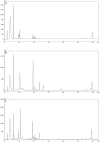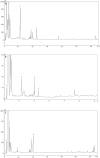Stem-leaves of Panax as a rich and sustainable source of less-polar ginsenosides: comparison of ginsenosides from Panax ginseng, American ginseng and Panax notoginseng prepared by heating and acid treatment
- PMID: 33437168
- PMCID: PMC7790872
- DOI: 10.1016/j.jgr.2020.01.003
Stem-leaves of Panax as a rich and sustainable source of less-polar ginsenosides: comparison of ginsenosides from Panax ginseng, American ginseng and Panax notoginseng prepared by heating and acid treatment
Abstract
Background: Ginsenosides, which have strong biological activities, can be divided into polar or less-polar ginsenosides.
Methods: This study evaluated the phytochemical diversity of the saponins in Panax ginseng (PG) root, American ginseng (AG) root, and Panax notoginseng (NG) root; the stem-leaves from Panax ginseng (SPG) root, American ginseng (SAG) root, and Panax notoginseng (SNG) root as well as the saponins obtained following heating and acidification [transformed Panax ginseng (TPG), transformed American ginseng (TAG), transformed Panax notoginseng (TNG), transformed stem-leaves from Panax ginseng (TSPG), transformed stem-leaves from American ginseng (TSAG), and transformed stem-leaves from Panax notoginseng (TSNG)]. The diversity was determined through the simultaneous quantification of the 16 major ginsenosides.
Results: The content of ginsenosides in NG was found to be higher than those in AG and PG, and the content in SPG was greater than those in SNG and SAG. After transformation, the contents of polar ginsenosides in the raw saponins decreased, and contents of less-polar compounds increased. TNG had the highest levels of ginsenosides, which is consistent with the transformation of ginseng root. The contents of saponins in the stem-leaves were higher than those in the roots. The transformation rate of SNG was higher than those of the other samples, and the loss ratios of total ginsenosides from NG (6%) and SNG (4%) were the lowest among the tested materials. In addition to the conversion temperature, time, and pH, the crude protein content also affects the conversion to rare saponins. The proteins in Panax notoginseng allowed the highest conversion rate.
Conclusion: Thus, the industrial preparation of less-polar ginsenosides from SNG is more efficient and cheaper.
Keywords: AG, American ginseng; NG, Panax notoginseng; PG, Panax ginseng; SAG, the stem-leaves from American ginseng; SNG, the stem-leaves from Panax notoginseng; SPG, the stem-leaves from Panax ginseng; TAG, transformed American ginseng; TNG, transformed Panax notoginseng; TPG, transformed Panax ginseng; TSAG, transformed stem-leaves from American ginseng; TSNG, transformed stem-leaves from Panax notoginseng; TSPG, transformed stem-leaves from Panax ginseng; acid transformation; less-polar ginsenosides; root ginsenosides; stem-leaf ginsenosides.
© 2020 The Korean Society of Ginseng. Publishing services by Elsevier B.V.
Figures







Similar articles
-
Production of Minor Ginsenosides from Panax notoginseng Flowers by Cladosporium xylophilum.Molecules. 2022 Oct 5;27(19):6615. doi: 10.3390/molecules27196615. Molecules. 2022. PMID: 36235151 Free PMC article.
-
Chemical Diversity of Panax ginseng, Panax quinquifolium, and Panax notoginseng.J Ginseng Res. 2012 Jan;36(1):1-15. doi: 10.5142/jgr.2012.36.1.1. J Ginseng Res. 2012. PMID: 23717099 Free PMC article.
-
Intraconversion of Polar Ginsenosides, Their Transformation into Less-Polar Ginsenosides, and Ginsenoside Acetylation in Ginseng Flowers upon Baking and Steaming.Molecules. 2018 Mar 26;23(4):759. doi: 10.3390/molecules23040759. Molecules. 2018. PMID: 29587462 Free PMC article.
-
Red ginseng and cancer treatment.Chin J Nat Med. 2016 Jan;14(1):7-16. doi: 10.3724/SP.J.1009.2016.00007. Chin J Nat Med. 2016. PMID: 26850342 Review.
-
Phytochemistry and Anticancer Potential of Notoginseng.Am J Chin Med. 2016;44(1):23-34. doi: 10.1142/S0192415X16500026. Am J Chin Med. 2016. PMID: 26916912 Review.
Cited by
-
A systematic exploration of ginsenoside Rg5 reveals anti-inflammatory functions in airway mucosa cells.J Ginseng Res. 2023 Jan;47(1):97-105. doi: 10.1016/j.jgr.2022.06.001. Epub 2022 Jul 5. J Ginseng Res. 2023. PMID: 36644392 Free PMC article.
-
Integrative metabolomic and transcriptomic reveals potential mechanism for promotion of ginsenoside synthesis in Panax ginseng leaves under different light intensities.Front Bioeng Biotechnol. 2023 Nov 22;11:1298501. doi: 10.3389/fbioe.2023.1298501. eCollection 2023. Front Bioeng Biotechnol. 2023. PMID: 38076416 Free PMC article.
-
Study on Chemical Constituents of Panax notoginseng Leaves.Molecules. 2023 Feb 27;28(5):2194. doi: 10.3390/molecules28052194. Molecules. 2023. PMID: 36903439 Free PMC article.
-
Rare ginsenosides: A unique perspective of ginseng research.J Adv Res. 2024 Dec;66:303-328. doi: 10.1016/j.jare.2024.01.003. Epub 2024 Jan 7. J Adv Res. 2024. PMID: 38195040 Free PMC article. Review.
-
Thermal Control Using Far-Infrared Irradiation for Producing Deglycosylated Bioactive Compounds from Korean Ginseng Leaves.Molecules. 2022 Jul 26;27(15):4782. doi: 10.3390/molecules27154782. Molecules. 2022. PMID: 35897960 Free PMC article.
References
-
- Wang C.Z., Wu J.A., Mcentee E., Yuan C.S. Saponins composition in American ginseng leaf and berry assayed by high-performance liquid chromatography. J. Agric. Food. Chem. 2006;54:2261–2266. - PubMed
LinkOut - more resources
Full Text Sources
Other Literature Sources

